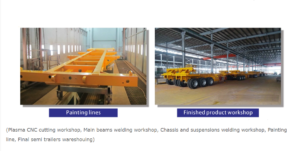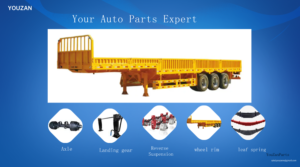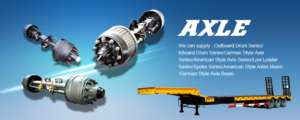The air suspension system is a critical component for single-axle liftable semi-trailers, offering improved ride quality, load stability, and reduced wear and tear on both the cargo and the vehicle itself. This article will guide you through the installation process of an air suspension system on a single-axle liftable semi-trailer and provide insights into its proper usage.

Installation of Air Suspension on Single-Axle Liftable Semi-Trailer
- Preparation: Before starting the installation, ensure that you have all the necessary components, including airbags, air control units, air lines, and mounting hardware. It is also essential to refer to the manufacturer’s guidelines and technical specifications for the air suspension system.
- Mounting Airbags: The airbags should be positioned at the designated locations on the semi-trailer’s axle. They need to be secured properly to the mounting brackets, ensuring that they are evenly distributed to provide balanced support for the trailer.
- Installing Air Control Units: The air control units, which manage the air flow to the airbags, should be installed in a protected location on the semi-trailer. They must be connected to a power source and have access to an air supply.
- Connecting Air Lines: The air lines must be routed from the air control units to the airbags, ensuring that they are secured and protected from damage. The lines should be checked for leaks before the system is pressurized.
- System Pressurization: Once all the components are connected, the system should be pressurized according to the manufacturer’s instructions. This step will help identify any leaks or issues with the air lines or connections.
- Adjustment and Testing: After pressurization, the air suspension system should be adjusted to achieve the correct ride height and air pressure. The system should then be tested to ensure that it operates smoothly and that the airbags are inflating and deflating as required.
Usage of Air Suspension on Single-Axle Liftable Semi-Trailer
- Regular Inspections: Regularly inspect the air suspension system for any signs of wear, damage, or leaks. Check the airbags for tears or punctures and ensure that the air lines are in good condition.
- Maintaining Air Pressure: It is essential to maintain the correct air pressure in the system. Regularly check the air pressure using a reliable gauge and adjust it according to the manufacturer’s specifications.
- Loading and Unloading: When loading or unloading cargo, ensure that the weight is distributed evenly across the semi-trailer. The air suspension system should be adjusted to accommodate the weight changes and maintain the proper ride height.
- Driving Techniques: When operating the semi-trailer with an air suspension system, be mindful of the road conditions and adjust your driving accordingly. Avoid sudden movements and sharp turns that can put excessive stress on the suspension system.
- Maintenance and Repairs: Perform regular maintenance on the air suspension system, including cleaning, lubricating, and replacing parts as needed. If any issues arise, seek professional assistance for repairs to ensure the system’s proper functioning.
Conclusion
The proper installation and usage of an air suspension system on a single-axle liftable semi-trailer can significantly enhance the vehicle’s performance and extend its service life. By following the manufacturer’s guidelines and conducting regular inspections and maintenance, you can ensure that the air suspension system operates efficiently and provides the necessary support for safe and smooth transportation. With the right care and attention, your semi-trailer’s air suspension system will serve as a reliable component in your logistics operations.




